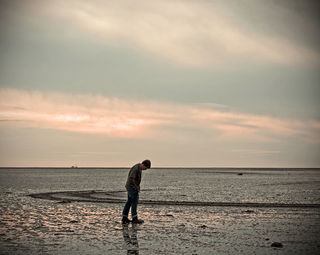Loneliness
Who Experiences More Loneliness, Men or Women?
New research explores the development of loneliness in midlife and old age.
Posted January 22, 2020 Reviewed by Gary Drevitch

Stereotypes of loneliness suggest that loneliness increases with age. We begin life with a wide and dynamic social network. Over time, friendships dissolve, people go their separate ways, and friends and acquaintances become harder to come by.
But does the stereotype match reality? New research published in the Journal of Personality and Social Psychology examined the development of loneliness across the lifespan. Interestingly, the researchers found that the trajectory of loneliness in midlife and old age depended on a person's gender — with men experiencing more loneliness in midlife and women experiencing more loneliness in old age.
"Loneliness is commonly defined as a response to a perceived discrepancy between the desired quantity and quality of social life and actual social relationships," state the authors of the research, led by Tilmann von Soest of the University of Oslo. "The results showed substantial gender differences in age trends in loneliness, with steadily increasing loneliness from age 40 to 80 for women, whereas men's level of loneliness followed a U-shaped curve, with highest loneliness levels at age 40 and 80 and lower levels in between."
To arrive at this conclusion, the researchers examined data from the Norwegian Life Course, Aging, and Generation Study. In this study, over 5,000 Norwegian adults responded to a series of questions that explored their attitudes and expectations toward aging. The study was conducted in two waves, first in 2002 and then again in 2007.
The researchers were primarily interested in people's responses to three agree-disagree statements regarding loneliness:
- "I miss having a really close friend."
- "I find my circle of friends and acquaintances too limited."
- "There aren't many people I can trust completely."
They also tracked participants' gender, age, employment and marital status, as well as various aspects of their personality.
Interestingly, they found that the disparity in the trajectories of loneliness for men and women was too vast to be ignored. They state, "The present study is [...] one of the first to provide indications of age trends that are contingent on gender."
The gender difference was not the only finding of interest. The researchers also found that social and environmental circumstances contributed to the development of loneliness in later life. They wrote, "Analyses revealed that having a disability, not having a spouse/cohabiting partner, and having experienced widowhood were each associated with reporting higher levels of loneliness." Furthermore, they found that people who scored higher on the personality traits of emotional stability and extraversion experienced less loneliness overall, and less of an increase in loneliness during old age.
The authors concluded, "Future research efforts need to corroborate and replicate our initial findings using well-characterized study samples representing other, preferably more heterogeneous and less well-functioning population segments."
Facebook image: 9nong/Shutterstock
References
von Soest, T., Luhmann, M., Hansen, T., & Gerstorf, D. (2018). Development of loneliness in midlife and old age: Its nature and correlates. Journal of Personality and Social Psychology.


